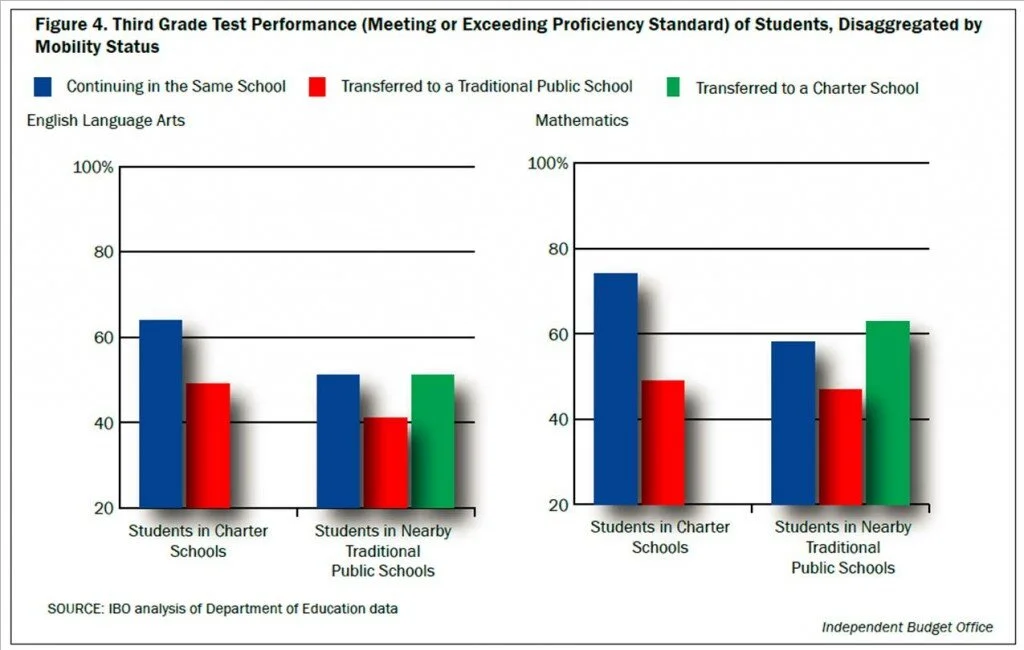Charter Schools in New York don’t see high transfer rates, outperform traditional schools
The New York City Independent Budget Office just released an interesting report on charter school student mobility.
Here are some of the findings:
• On average, students at charter schools stay at their schools at a higher rate than students at nearby traditional public schools. About 70 percent of students attending charter schools in school year 2008-2009 remained in the same school three years later, compared with 61 percent of students attending nearby traditional public schools three years later.
• This is the case even when the overall student population is separated into various subgroups based on gender, race, poverty status, and English language learner status. For most subgroups, students in charter schools leave their schools at a lower rate.
• This higher rate of staying at charter schools also is found when students are compared in terms of gender, race/ethnicity, poverty, and English learner status.
• The one major exception is special education students, who leave charter schools at a much higher rate than either general education students in charter schools or special education students in traditional public schools. Only 20 percent of students classified as requiring special education services who started kindergarten in charter schools remained in the same school after three years. The corresponding persistence rate for students in nearby traditional public schools is 50 percent.
• Looking at the third grade performance of students who started kindergarten in traditional public schools but later switched to charter schools, they had lower test scores compared with the stayers in charter schools, but higher test scores than those who transferred out from charter schools.
So, the idea that lots of kids are pushed out of charters does not hold up in New York City with the possible exception of kids with learning disabilities. And, the mobility of learning disabled students even in the city’s traditional schools is also high.
There is a lot more in the report, but I found this graph of test results especially interesting. It shows how students in both charters and traditional schools who stayed in place or transferred performed on New York’s English language arts and math tests.
Let’s demystify this somewhat involved graph.
Look at the far left blue and red bars in the English Language Arts part of the graph. The blue bar is considerably larger than the red one, which tells us that students who stayed in charter schools from Kindergarten through the third grade did much better on the state ELA test than those who transferred to a traditional public school. Advantage – student remaining in charter.
Next, compare that first blue bar to the other blue bar in the ELA section of the graph. That second blue bar shows the percentage of students in the traditional nearby schools that also met the performance standard for New York. The charter bar is much larger than the traditional bar, showing that charter school students who remained in charter schools for Kindergarten to the third grade notably outscored students who stayed in the traditional public schools for the same length of time. Advantage – student in charter over traditional public school.
Now, compare the two red bars. These show that even if a student left a charter school and transferred to a traditional public school, they still outperformed a student who transferred from one traditional school to another. Advantage – student even with only some charter experience over traditional public school.
Finally, compare the blue bar for the traditional public school section of the graph to the green bar. Keep in mind that students would have transferred at some time after Kindergarten and may not have spent more than a year in the charter school world. There is no difference in performance for English language arts, but in math even a late transfer to charter schools has an advantage over the traditional public school student who never transfers. Advantage – student even with only some charter experience over traditional public school.
Bottom line: why do Kentucky adult interests continue to trump the best needs of students by blocking charter school legislation for our state? Well run charter schools are demonstrating they do a better job for students, and isn’t our education system supposed to be for the kids, first?

